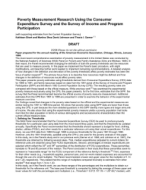
An official website of the United States government
Here’s how you know
Official websites use .gov
A .gov website belongs to an official government organization in the United States.
Secure .gov websites use HTTPS
A lock (
) or https:// means you’ve safely connected to the .gov website. Share sensitive information only on official, secure websites.
-
//
- Census.gov /
- Library /
- Census Working Papers /
- Poverty Measurement Research
Poverty Measurement Research Using the Consumer Expenditure Survey and the Survey of Income and Program Participation
Poverty Measurement Research Using the Consumer Expenditure Survey and the Survey of Income and Program Participation
Introduction
Paper prepared for the annual meeting of the American Economic Association, Chicago, Illinois, January 1998.
The most recent comprehensive examination of poverty measurement in the United States was conducted by the National Academy of Sciences (NAS) Panel on Poverty and Family Assistance (Citro and Michael, 1995). In their report, the Panel recommended changing the definition of both the poverty thresholds and the resources that are used to measure poverty. In this paper we implement the Panel's basic procedure, with slight modifications, and describe further work needed to implement remaining recommendations. A detailed analysis of how changes in the definition and derivation of the poverty thresholds affect poverty estimates has been the focus of earlier research(2). The primary focus here is to describe how resources might be defined and how changes in the definition of resources would affect poverty rates.
This paper presents poverty estimates using thresholds derived from Consumer Expenditure Survey (CEX) data for 1989 to 1991, and family resources based on data from the 1991 panel of the Survey of Income and Program Participation (SIPP) and the March 1992 Current Population Survey (CPS). The resulting poverty rates are compared with those based on the official measure. While previous work(3) has examined the experimental poverty measure exclusively using the CPS, this paper presents, for the first time, estimates from the SIPP, the survey that the Panel recommended become the official source of poverty resource measurement. Additional estimates from the CPS from 1991 to 1996 are presented in order to examine the behavior of the experimental measure over time.
Our findings reveal that changes in the poverty rates based on the official and the experimental measures are similar during the 1991 to 1996 time period. We show that poverty rates using SIPP data are lower than those using the CPS, in part because the more detailed questions in the SIPP identify more types and larger amounts of income. We also show that using the experimental poverty measure yields a poverty population that looks more like the total population in terms of various demographic and socioeconomic characteristics than the current official measure does.
Others in Series
Working Paper
Working Paper
Working Paper
Share
Related Information
WORKING PAPER
Supplemental Poverty Measure Working PapersSome content on this site is available in several different electronic formats. Some of the files may require a plug-in or additional software to view.
 Yes
Yes
 No
NoComments or suggestions?


Top

